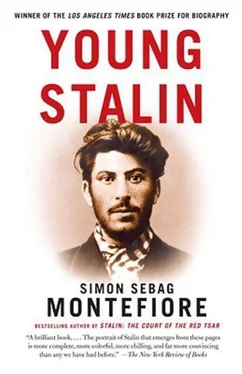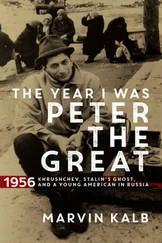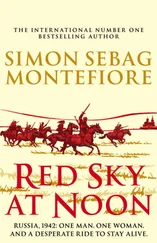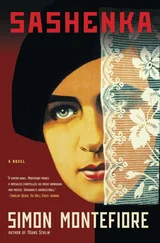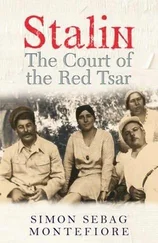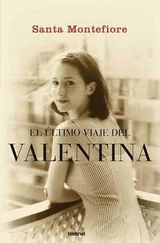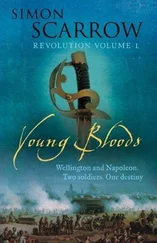The Russian teachers [20]were brutal pedants in Russian uniforms—tunics with gold buttons and peaked caps—who disdained the Georgian language. But one teacher was beloved—the singing master Simon Gogchilidze, a kindly dandy who always wore the latest fashions: spats, winged collars and a buttonhole. The schoolgirls were in love with him and even wrote songs about him. His favourite choirboy was Stalin, whom he tried to help in every way: “In two years, he learned music and began to help the conductor. There were a lot of solos and Soso always sang them…” It was not just his “beautiful, sweet high voice,” writes the romantic teacher, but his “grand style of performance.” Stalin was often hired to sing at weddings: “People would turn up just to watch him sing, saying, ‘Let’s go see how the Djugashvili boy amazes everyone with that voice.’” When Stalin “appeared for the solo in the pulpit wearing his surplice and sang in his wondrous alto, it delighted everyone!”
During these first school years, Stalin was so devout that he barely missed a mass. “He not only performed the rites but always reminded us of their significance,” says a schoolfellow, A. Chelidze. Another, Suliashvili, remembers Stalin and two other boys in church, “wearing their surplices, kneeling, faces raised, singing Vespers with angelic voices while the other boys prostrated themselves filled with an ecstasy not of this world.” He was the “best reader of Psalms” in church. Others were only permitted to read after being tutored by Soso himself. The grateful school presented him with David’s Book of Psalms inscribed “To Josef Djugashvili… for excellent progress, behaviour and excellent recitation and singing of the Psalter.”
Soso also painted well and showed a taste for acting that would remain with him. He appeared in a satirical vaudeville that mocked Shakespeare: “Soso’s expression made the audience burst into laughter!” He was already starting to write poetry: “He wrote verses instead of letters to his friends.” [21]
He was also the school’s most outstanding pupil in class. “He was a very clever boy,” said the singing teacher. “Nobody remembers him scoring anything less than 5s [A grades].” Soso “spent his spare time reading books.” He “often carried volumes stuck into the belt of his trousers” and liked to help less intelligent children with their work. “He never missed a class or arrived late and aimed always to be first in everything,” says his classmate Petre Aadamshvili—whom he advised: “Improve yourself. Don’t be lazy or you’ll lose in life.”
Even the Georgia-phobe teachers were impressed with Stalin’s knowledge. School Inspector Butyrsky used to excuse himself from social events saying he had to go home to study because “if I’m not prepared [for tomorrow’s class], there’s a pupil named Djugashvili who’s sure to catch me out!” [22]Stalin was such a goody-goody that when he was on class duty he marked down anyone who was late or tried to cheat. The other boys even nicknamed him “the Gendarme.”
Yet the class pet was never deferential. When the school went on an expedition and one of the boys let Inspector Butyrsky ride over a stream on his back, Stalin sneered: “What are you, a donkey? I’d never let God himself ride on my back, let alone some school inspector.” When the beloved Gogchilidze tried to persuade him to perform a song he did not like, Soso did not turn up on the day.
Lavrov, the most hated teacher and a persecutor of all things Georgian, appointed Stalin his “assistant,” a decision he soon regretted. When Lavrov tried to force his “assistant” to inform on anyone speaking Georgian, Stalin acted. Backed up by some tough eighteen-year-olds, he lured the teacher into an empty classroom and threatened to kill him. Lavrov became much more compliant.
At the end of the fourth year, Stalin decided that his choir should pose for a portrait. The singing master heard him “dividing the tasks—one boy was to gather money, another to book the photographer and when we gathered [Stalin] arrived with a bunch of flowers, ordering the boys to put them in their buttonholes and arranging them for the photograph.”
Yet there was always a shadow over Soso: Crazy Beso arrived drunk and seized him from the church school, demanding he become a cobbler. Keke appealed to her protectors: “I raised the entire world, my brothers, godfather Egnatashvili, the teacher…” and Beso “returned my son to me.” But Beso repeatedly “burst into the school drunkenly to grab Soso by force.” Henceforth, Soso had to be smuggled into school literally under the coat of Keke’s brothers while “everyone helped and hid the child, telling the infuriated Beso that Soso wasn’t even at the school.”
The schoolboy Stalin, like the politician he became, was a bundle of contradictions: “Soso Djugashvili,” Iremashvili sums up, “was the best but also the naughtiest pupil.” Stalin’s childhood had already been a triumph over misfortune. But just as he was prospering at school, he again faced a series of terrible blows that almost destroyed him. {50}
On 6 January 1890, the choirboys, shepherded by singing teacher Gogchilidze, were trooping out of church after the Epiphany Day blessing for Gori’s Russian garrison. “No one noticed a runaway phaeton,” recalled Gogchilidze, which galloped straight into the crowd. Stalin, now twelve, was just crossing the road when the carriage “hurtled towards him, a pole hit his cheek, knocking him off his feet, [the wheels] running over his legs. The crowd stood round him and picked up the child who had lost consciousness and we carried him away.” The coachman was arrested and later sentenced to a month in jail, but poor Keke again had her bloodied child borne home. When he came round, he saw his desperate mother. “Don’t worry, Mummy, I’m all right,” he said pluckily. “I’m not going to die.” {51}
The injuries were so grave that Soso was taken to hospital in Tiflis, the capital, missing school for months. His legs were seriously damaged. Years later at the seminary, he complained of “sore legs” and, even when he recovered, he walked in the heavy, sideways gait that won him another nickname. Already the Pockmarked (Chopura), he became the Loper (Geza). More than ever, he must have yearned to prove his strength yet also enjoyed the confidence of overcoming such adversity.
The accident brought Beso out of the shadows with a vengeance—the cobbler probably visited the boy in Tiflis. Keke had to let him know that the child was so ill. But Beso could not resist an opportunity to reimpose himself on his defiant family. As soon as Soso had recovered in Tiflis, his father kidnapped the boy and enrolled him as an apprentice cobbler at the Adelkhanov Shoe Factory, where he himself worked.
“You want my son to be a bishop? Over my dead body, he’ll be educated!” he shouted at Keke. “I’m a shoemaker and my son will be one too.”
Beso and his son now toiled with the eighty-strong Adelkhanov workforce for long hours and low wages in a half-flooded cellar lit by kerosene lamps amid the almost faecal reek of tanning leather. The stink made grown men vomit. Even the Tsarist authorities were worried about the number of child workers in Adelkhanov’s grim rectangular factory. Living with his father in a room in the Avlabar workers’ district and walking into work over the bridge past the Metekhi Fortress-Prison, Soso had to carry shoes from the factory to the shop-warehouse in the bazaar off Yerevan Square. Apart from the short spell in his father’s Gori workshop, this was to be Stalin’s only experience of a worker’s existence during a life devoted to the proletariat. If Beso had succeeded, there would have been no Stalin, for he would have remained uneducated. Stalin owed his political success to his unusual combination of street brutality and classical education.
Читать дальше
